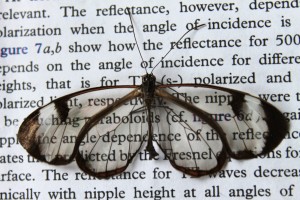Covered in an Oct. 19, 2016 posting here, some new details have been released about noniridescent photonics and blue tarantulas, this time from the Karlsruhe Institute of Technology (KIT) in a Nov. 17, 2016 (?) press release (also on EurekAlert; h/t Nanowerk Nov. 17, 2016 news item) ,
Colors are produced in a variety of ways. The best known colors are pigments. However, the very bright colors of the blue tarantula or peacock feathers do not result from pigments, but from nanostructures that cause the reflected light waves to overlap. This produces extraordinarily dynamic color effects. Scientists from Karlsruhe Institute of Technology (KIT), in cooperation with international colleagues, have now succeeded in replicating nanostructures that generate the same color irrespective of the viewing angle. DOI: 10.1002/adom.201600599
In contrast to pigments, structural colors are non-toxic, more vibrant and durable. In industrial production, however, they have the drawback of being strongly iridescent, which means that the color perceived depends on the viewing angle. An example is the rear side of a CD. Hence, such colors cannot be used for all applications. Bright colors of animals, by contrast, are often independent of the angle of view. Feathers of the kingfisher always appear blue, no matter from which angle we look. The reason lies in the nanostructures: While regular structures are iridescent, amorphous or irregular structures always produce the same color. Yet, industry can only produce regular nanostructures in an economically efficient way.
Radwanul Hasan Siddique, researcher at KIT in collaboration with scientists from USA and Belgium has now discovered that the blue tarantula does not exhibit iridescence in spite of periodic structures on its hairs. First, their study revealed that the hairs are multi-layered, flower-like structure. Then, the researchers analyzed its reflection behavior with the help of computer simulations. In parallel, they built models of these structures using nano-3D printers and optimized the models with the help of the simulations. In the end, they produced a flower-like structure that generates the same color over a viewing angle of 160 degrees. This is the largest viewing angle of any synthetic structural color reached so far.
Flower-shaped nanostructures generate the color of the blue tarantula. (Graphics: Bill Hsiung, University of Akron)
The 3D print of the optimized flower structure is only 15 µm in dimension. A human hair is about three times as thick. (Photo: Bill Hsiung, Universtiy of Akron)Apart from the multi-layered structure and rotational symmetry, it is the hierarchical structure from micro to nano that ensures homogeneous reflection intensity and prevents color changes.
Via the size of the “flower,” the resulting color can be adjusted, which makes this coloring method interesting for industry. “This could be a key first step towards a future where structural colorants replace the toxic pigments currently used in textile, packaging, and cosmetic industries,” says Radwanul Hasan Siddique of KIT’s Institute of Microstructure Technology, who now works at the California Institute of Technology. He considers short-term application in textile industry feasible.
The synthetically generated flower structure inspired by the blue tarantula reflects light in the same color over a viewing angle of 160 degrees. (Graphics: Derek Miller)Dr. Hendrik Hölscher thinks that the scalability of nano-3D printing is the biggest challenge on the way towards industrial use. Only few companies in the world are able to produce such prints. In his opinion, however, rapid development in this field will certainly solve this problem in the near future.
Once again, here’s a link to and a citation for the paper,
Tarantula-Inspired Noniridescent Photonics with Long-Range Order by Bor-Kai Hsiung, Radwanul Hasan Siddique, Lijia Jiang, Ying Liu, Yongfeng Lu, Matthew D. Shawkey, and Todd A. Blackledge. Advanced Materials DOI: 10.1002/adom.201600599 Version of Record online: 11 OCT 2016
© 2016 WILEY-VCH Verlag GmbH & Co. KGaA, Weinheim
The paper is behind a paywall. You can see the original Oct. 19, 2016 posting for my comments and some excerpts from the paper.



